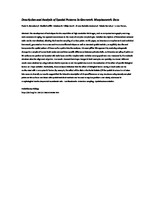Repositorio Digital
Description and analysis of spatial patterns in geometric morphometric data
- DSpace Principal
- →
- Hospital El Cruce
- →
- Publicaciones
- →
- Artículos
- →
- Ver ítem
JavaScript is disabled for your browser. Some features of this site may not work without it.
Mostrar el registro sencillo del ítem
| dc.contributor.author | Gonzalez, Paula | |
| dc.contributor.author | Bonfili, Noelia | |
| dc.contributor.author | Azar, Mariana | |
| dc.contributor.author | Barbeito-Andres, Jimena | |
| dc.contributor.author | Bernal, Valeria | |
| dc.contributor.author | Perez, S. Ivan | |
| dc.date.accessioned | 2019-06-04T18:02:47Z | |
| dc.date.available | 2019-06-04T18:02:47Z | |
| dc.date.issued | 2019 | |
| dc.identifier.issn | 1934-2845 | |
| dc.identifier.uri | https://doi.org/10.1007/s11692-019-09479-5 | |
| dc.identifier.uri | https://link.springer.com/article/10.1007/s11692-019-09479-5 | |
| dc.identifier.uri | http://repositorio.hospitalelcruce.org/xmlui/handle/123456789/870 | |
| dc.description | Fil: Gonzalez, Paula. Hospital de Alta Complejidad en Red El Cruce Dr. Néstor C. Kirchner. Centro Nacional de Alta Complejidad en Neurociencias y Neurocirugía. Florencio Varela, Argentina. | es_AR |
| dc.description.abstract | The development of techniques for the acquisition of high-resolution 3D images, such as computed tomography and magnetic resonance imaging, has opened new avenues to the study of complex morphologies. Detailed descriptions of internal and external traits can be now obtained, allowing the intensive sampling of surface points. In this paper, we introduce a morphometric and statistical framework, grounded on Procrustes and Procrustes-like techniques as well as standard spatial statistics, to explicitly describe and incorporate the spatial pattern of these surface points into the analyses. We exemplified this approach by analyzing ontogenetic changes in a sample of human brain endocasts and inter-specific differences between primate skulls. An intensive sampling of points on 3D surfaces was performed by automatic techniques and the morphometric variation among specimens was measured by the residuals obtained after the alignment of points. Our results showed that shape changes in both examples are spatially structured. Different results were attained by using methods that incorporate or not the spatial structure in the evaluation of the effect of specific biological factors on shape variation. Particularly, these analyses indicated that the effect of biological factors acting at local scales can be confounded with more systemic factors (by example, the effect of the diet on the facial skeleton) if the spatial structure is not taken into account. Overall, our results suggest that the intensive description of shape differences among structures using densely sampled points on 3D surfaces combined with spatial statistical methods can be used to explore problems not widely addressed in morphological studies. | es_AR |
| dc.language.iso | en_US | es_AR |
| dc.relation.ispartofseries | Evolutionary Biology; | |
| dc.subject | Imagen Tridimensional | es_AR |
| dc.subject | Diagnóstico por Imagen | es_AR |
| dc.subject | Análisis Espacial | es_AR |
| dc.title | Description and analysis of spatial patterns in geometric morphometric data | es_AR |
| dc.type | Article | es_AR |
Ficheros en el ítem
Este ítem aparece en la(s) siguiente(s) colección(ones)
-
Artículos
Articles

